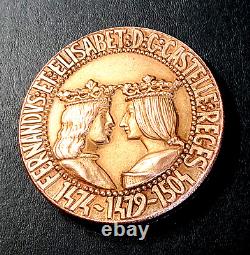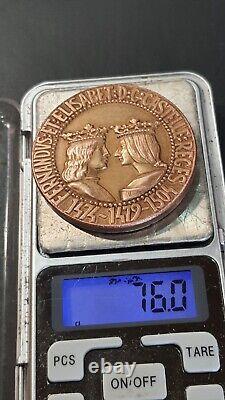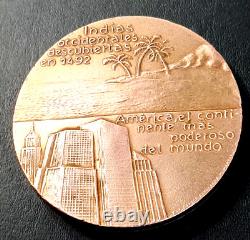Royal Marriage of Isabella I of Castile Ferdinand II of Aragon Spanish medal





23 January 1516 (aged 63) Madrigalejo. Alonso, Archbishop of Zaragoza and Viceroy of Aragon.
Joanna, Queen of Castile and Aragon. John II of Aragon and Navarre. Fernando ; 10 March 1452 - 23 January 1516 was King of Aragon. From 1479 until his death in 1516.
As the husband of Queen Isabella I of Castile. He was also King of Castile. From 1475 to 1504 (as Ferdinand V). He reigned jointly with Isabella over a dynastically unified.
Together they are known as the Catholic Monarchs. Ferdinand is considered the de facto first king of Spain. And was described as such during his reign, even though, legally, Castile. Remained two separate kingdoms until they were formally united by the Nueva Planta decrees. Issued between 1707 and 1716.That Ferdinand inherited in 1479 included the kingdoms of Aragon. As well as the Principality of Catalonia. His marriage to Isabella is regarded as the "cornerstone in the foundation of the Spanish monarchy".
They played a major role in the European colonization of the Americas. Sponsoring the first voyage of Christopher Columbus. That year the couple defeated Granada. The last Muslim state in Western Europe. Thus completing the centuries-long Reconquista. Following Isabella's death in 1504, the couple's daughter Joanna. Became queen of the Crown of Castile. That year, after a war with France, Ferdinand conquered the Kingdom of Naples.In 1507 he became regent. Of Castile on behalf of Joanna, who was alleged to be mentally unstable. In 1506, as part of a treaty with France, Ferdinand married Germaine of Foix. With whom he had no surviving children.
In 1512 he conquered most of the Kingdom of Navarre. Ruling all the territories comprising modern-day Spain until his death in 1516. He was nominally succeeded by his daughter Joanna, but power was soon assumed by her son Charles I later Holy Roman Emperor Charles V. Ferdinand was born on 10 March 1452, in the town of Sos del Rey Católico. As the son of John II of Aragon.Whose family was a cadet branch of the House of Trastámara. By his second wife, Juana Enríquez. The half-sister and heir presumptive of Henry IV of Castile.
On 19 October 1469 in Valladolid. Kingdom of Castile and Leon. Isabella also belonged to the royal House of Trastámara.
And the two were second cousins by descent from John I of Castile. They were married with a clear prenuptial agreement. On sharing power, and under the joint motto tanto monta, monta tanto. King of Castile when Isabella succeeded her deceased brother in 1474.
The two young monarchs were initially obliged to fight a civil war. The purported daughter of Henry IV, and were swiftly successful. When Ferdinand succeeded his father as King of Aragon in 1479, the Crown of Castile and the various territories of the Crown of Aragon were united in a personal union.
The various states were not formally administered as a single unit, but as separate political units under the same monarchs. The legal merging of Aragon and Castile.
Into a single Spain occurred under Philip V. Ferdinand the Catholic swearing the fueros as the Lord of Biscay. Soliciting aid of Ferdinand's wife Isabella. The first years of Ferdinand and Isabella's joint rule saw the Spanish conquest of the Emirate of Granada.
Entity on the Iberian peninsula, completed in 1492. The completion of the Reconquista.
Was not the only significant act performed by Ferdinand and Isabella in that year. In March 1492, the monarchs issued the Edict of Expulsion of the Jews, also called the Alhambra Decree.A document which ordered all Jews. Either to be baptised and convert to Christianity or to leave the country. Jews to stay, while expelling all unconverted Jews from Castile and Aragon (most Jews either converted or moved to the Ottoman Empire). 1492 was also the year in which the monarchs commissioned Christopher Columbus.
To find a westward maritime route for access to Asia, which resulted in the Spanish arrival in the Americas. In 1494 the Treaty of Tordesillas. Divided the entire world beyond Europe between Portugal.And Castile (Spain) for conquest and dominion purposes - by a north-south line drawn down the Atlantic Ocean. Ferdinand abrogated a section of the 1491 Treaty of Granada. Peace treaty in 1502 by dismissing the clearly guaranteed religious freedom for Mudéjar. Ferdinand forced all Muslims in Castile and Aragon to convert, converso.
To Catholicism, or else be expelled. Some of the Muslims who remained were mudéjar artisans, who could design and build in the Moorish style. This was also practised by the Spanish inquisitors on the converso Marrano.
Wedding portrait of Ferdinand and Isabella. The latter part of Ferdinand's life was largely taken up with disputes with successive kings of France.Over control of Italy, the Italian Wars. In 1494, Charles VIII of France.
Invaded Italy and expelled Alfonso II. Who was Ferdinand's first cousin once removed and step nephew, from the throne of Naples.
Ferdinand allied with various Italian princes and with Emperor Maximilian I. To expel the French by 1496 and install Alfonso's son, Ferdinand II.
In 1501, following Ferdinand II's death and accession of his uncle Frederick. Ferdinand signed an agreement with Charles VIII's successor, Louis XII. Who had just successfully asserted his claims to the Duchy of Milan. To partition Naples between them, with Campania. Including Naples itself, going to the French and Ferdinand taking Apulia.
The agreement soon fell apart and, over the next several years, Ferdinand's great general Gonzalo Fernández de Córdoba. Fought to take Naples from the French, finally succeeding by 1504. The King of France complains that I have twice deceived him. He lies, the fool; I have deceived him ten times and more. Some time before 1502 Andreas Palaiologos. The last exiled claimant to the Byzantine throne. Those, however, had never been made use of, due to the doubtful nature of the deal. 22 April 1451 Madrigal de las Altas Torres. 26 November 1504 (aged 53) Medina del Campo. Isabel I ; 22 April 1451 - 26 November 1504. Also called Isabella the Catholic (Spanish: Isabel la Católica), was Queen of Castile. From 1474 until her death in 1504. She was also Queen of Aragon. From 1479 until her death as the wife of King Ferdinand II. Reigning together over a dynastically unified. Isabella and Ferdinand are known as the Catholic Monarchs. After a struggle to claim the throne, Isabella reorganized the governmental system, brought the crime rate down, and unburdened the kingdom of the debt.Her half-brother King Henry IV. Isabella's marriage to Ferdinand in 1469 created the basis of the de facto unification of Spain.
Her reforms and those she made with her husband had an influence that extended well beyond the borders of their united kingdoms. Isabella I of Castile and Ferdinand II of Aragon are known for being the first monarchs to be referred to as the "Queen of Spain" and "King of Spain" respectively. Their actions included completion of the Reconquista.Which ordered the mass expulsion of Jews. And establishing the Spanish empire.
Making Spain a major power in Europe and ultimately ushering in the Spanish Golden Age. Together with her husband, Isabella was granted the title of "Catholic Monarch" by the Spanish Pope Alexander VI. And was recognized in 1974 as a Servant of God.

